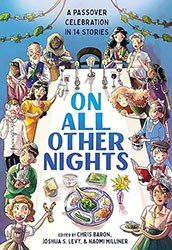Your gift giving problems are now over — just stock up on The 100 Most Jewish Foods: A Highly Debatable List. This book will help deal with one of life’s most persistent problems, the appropriate gift for any occasion — hostess present, Hanukkah, engagement, birthday, or get well. Well, maybe not a bar or bat mitzvah, but suitable and absolutely enjoyable for almost any other occasion.
In 2018, a list of the most Jewish foods appeared in Tablet magazine. It was met with such an enthusiastic and lively response that it prompted Alana Newhouse, the editor of Tablet, to compile this book. Although most dishes are familiar, others are traditional dishes that live mainly in Jewish memory, like the unhatched eggs that once in awhile came with your chicken back in the days when a chicken was complete with feet, gizzards, hearts, livers, necks, and no plastic covering. There’s the time-consuming multilayered flódni, which dates to about the year 1000 and made its home in nineteenth-century Hungarian-speaking Europe, and ptcha, calves-foot jelly (bones included), a once popular Shabbat delicacy. And, of course, there are the foods, like chopped liver and blintzes, that most readers will recognize, to their pleasure or their distaste. The delight of the book is turning the pages and agreeing heartily with the selection or saying no, never, to the next one.
Note the phrase “the most Jewish foods” — not the best or most famous. According to the editor, these foods have the “deepest Jewish significance,” even if they are no longer served. Reading through them is like reading Jewish history. Most of these foods originated in countries all over the globe, and they have been served for centuries while others blossomed in the diversity of the New World and American food.
Each dish is introduced by a well-known chef or food writer, and sixty are accompanied by recipes. Four-star chef Eric Ripert presents gefilte fish; farm-fresh food restaurateur Dan Barber riffs on apples; New York Times’ Melissa Clark bakes up black-and-white cookies; novelist Shalom Auslander unloads on cholent. Photographs of each dish are by Noah Fecks, and light-hearted illustrations by Joana Avillez dot the text.
Warning: Not all the most Jewish foods are kosher. Once in America, Jews responded, as they have for centuries, to the culture and foods around them and adopted new eating habits. The joy of this book, however, isn’t in the recipes but in the selection and the informative and good-humored descriptions of each dish. To paraphrase the title of a major history of Jewish food, “Read and be satisfied.”
Maron L. Waxman, retired editorial director, special projects, at the American Museum of Natural History, was also an editorial director at HarperCollins and Book-of-the-Month Club.




